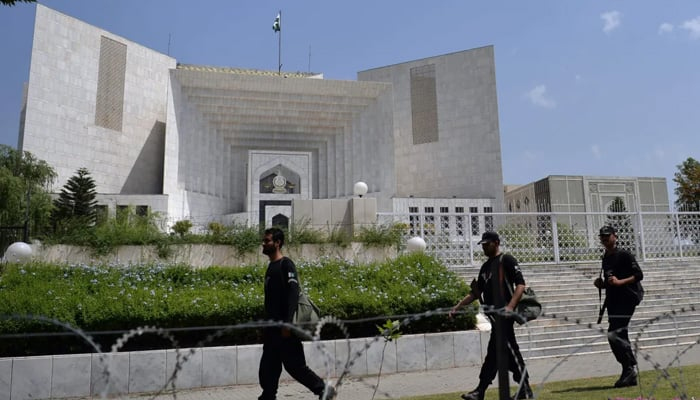Practice and procedure
The Supreme Court has given its findings on the much-debated Supreme Court (Practice and Procedure) Act 2023. Although the detailed judgment is awaited, still, the short order has said that from now on, at the Supreme Court, the constitution of benches and allocation of cases will be dealt with by a three-member committee of senior judges, including the chief justice. Previously, this power was held solely by the CJP.
The CJP’s approach to working with parliament by respecting each other's jurisdiction is not only encouraging but also the need of the day. Encouragingly, through this decision, the Supreme Court has not only accepted the supremacy of parliament but has also acknowledged the overdue reforms in the apex judiciary.
Factually, there are three important portions of the judgment. First, with a 10-5 majority the Act has been declared to be in accordance with the constitution. Second, with a 9-6 majority, Section 5(1) of the Act has been declared to be in accordance with the constitution; the section confers the right to appeal before a larger bench against the judgment of the SC exercising its powers under Article 184(3) of the constitution. Lastly, the same bench with an 8-7 majority declared Section 5(2) of the Act ultra vires the constitution, thereby removing the right to retrospective appeal against a judgment of the SC under Article 184-3 of the constitution.
This decision not only provides hope for institutional accountability but also hope for safeguarding the judiciary from internal interference and ensuring maximum transparency. Although the objective reforms were overdue, credit should be given to the former government for passing the law in the last days of its tenure.
Now the question is whether the law is sufficient for judicial independence and improving the justice delivery system in the country. We believe that there are still grey areas which can be overcome and improved by the judiciary through different internal administrative initiatives while others can be reformed through necessary legislation.
For instance, currently the High Court Rules empower a high court chief justice to constitute benches and allocate cases to each of them. This should be reformed on the pattern of the SC. There is also a need to work on special benches for special cases.
Therefore, the importance of having a certain internal mechanism for fixing cases on its turn, subject and specialty and with a window for very urgent and serious nature cases can further improve the process and ultimately ensure maximum transparency. There is a need to take further steps to refine the process of the constitution of benches, especially the allocation of cases with a special emphasis on fixation on the turn and subject of the cases.
The judicial approach of every judge of the SC and high court|(s) is usually gauged from his or her judgments. Sometimes judges are famous for being relief givers while others are infamous for being ‘grudges’ and not judges. In such a situation, the litigant would definitely try and wish to argue his or her case in front of a bench with judges with a generous approach.
The process of having the same benches for cases of the same nature, with specialist judges, can be of importance. It would not only curtail variation in the decision but would also minimize the grievances among the litigants and surely aid the internal independence of the judiciary.
Similarly, for improved service delivery, the role of bar councils, other lawyer bodies and allied organizations has always been of vital importance; the government can reform these bodies through proper legislation while the judiciary can overcome various ancillary shortcomings through internal administrative reforms. Auxiliary goals can also be achieved by encouraging and helping the young lawyers and facilitating the litigants for their feedback in ‘different scenarios’, which is currently missing.
Correspondingly, the performance of the judges can be improved robustly if proper training is given on the pattern of the bureaucracy. In our country, civil courts and the courts of magistrates do most of the trials in civil and criminal litigations, but judges are recruited with very minimum experience and provided with very inadequate training.
Similarly, reforming the process, administration and proceedings before the Supreme Judicial Council is of vital importance, which is facing various challenges and questions that have been raised on its function and transparency. Historically, an institution cannot survive and improve without an impartial and transparent internal accountability. Similarly, on the pattern of the SJC, there should be an internal watchdog for the accountability of the judges and allied staff of the lower judiciary. The accountability and administrative matters of the supporting staff of the subordinate judiciary are very important, and for improved administration of justice, many issues can be tackled through internal administrative reforms.
Although there have been encouraging reforms in the recent past, especially the use of technology in case management, there is still much space for improvement. Sadly, there have been administrative reforms by the former heads of the apex judiciary which are somehow person-specific. In the recent past, every chief justice of the Supreme Court and the high court(s) came with a reformation policy, some of which perished on their retirement while others were followed but with snail speed.
Finally, there is a need to reform the appointment procedure of judges of the high court. Besides the specific criteria, in accordance with the constitution, there should be detailed qualifications fixed to ensure maximum transparency including public interviews on the pattern of live telecast of SC proceedings to curtail nepotism and favouritism in the appointment of judges to the apex judiciary.
The writer is a Peshawar-based lawyer. He tweets/posts @s_irshadahmad and can be reached at: irshadahmadadvocate@gmail.com
-
 Ben Affleck Doesn't Want His Kids To Join Showbiz: Here's Why
Ben Affleck Doesn't Want His Kids To Join Showbiz: Here's Why -
 George R.R. Martin Calls 'House Of The Dragon' S3 'not My Story'
George R.R. Martin Calls 'House Of The Dragon' S3 'not My Story' -
 Kim Kardashian Gushes Over 'baby Girl' Chicago As She Turns 8
Kim Kardashian Gushes Over 'baby Girl' Chicago As She Turns 8 -
 Drew Barrymore Reflects Heartbreaking Body Shaming She Faced At Just 10
Drew Barrymore Reflects Heartbreaking Body Shaming She Faced At Just 10 -
 Pamela Anderson Felt 'weird' Seeing Seth Rogen After 'Pam & Tommy'
Pamela Anderson Felt 'weird' Seeing Seth Rogen After 'Pam & Tommy' -
 Kelly Clarkson Discovers A Shark Named In Her Honour
Kelly Clarkson Discovers A Shark Named In Her Honour -
 HBO Mulls Major 'Game Of Thrones' Spin-off Focusing On A Stark
HBO Mulls Major 'Game Of Thrones' Spin-off Focusing On A Stark -
 Ashton Kutcher Says He's Proud Of Demi Moore
Ashton Kutcher Says He's Proud Of Demi Moore -
 Why Prince William, Kate Hired A Crisis Expert Despite Royal 'calm'?
Why Prince William, Kate Hired A Crisis Expert Despite Royal 'calm'? -
 Extent Of Meghan Markle’s Fears Gets The Spotlight: ‘The Press Detest Her Which Is A Problem’
Extent Of Meghan Markle’s Fears Gets The Spotlight: ‘The Press Detest Her Which Is A Problem’ -
 Caitlyn Jenner Finally Reacts To Kylie, Timothee Chalamet Relationship
Caitlyn Jenner Finally Reacts To Kylie, Timothee Chalamet Relationship -
 Prince William’s Beefed Up PR All Set To Fight Off ‘plot’ And ‘it Might Not Be Long’
Prince William’s Beefed Up PR All Set To Fight Off ‘plot’ And ‘it Might Not Be Long’ -
 Kate Middleton Ups A New Role Unofficially For King Charles As William Prepares His Coronation
Kate Middleton Ups A New Role Unofficially For King Charles As William Prepares His Coronation -
 Teyana Taylor Says She Misread Leonardo DiCaprio Globes Moment
Teyana Taylor Says She Misread Leonardo DiCaprio Globes Moment -
 A$AP Rocky Reveals What Encouraged Him To Date Rihanna
A$AP Rocky Reveals What Encouraged Him To Date Rihanna -
 Newborns At Risk: Health Experts Warn Your Baby Could Already Have Diabetes
Newborns At Risk: Health Experts Warn Your Baby Could Already Have Diabetes




